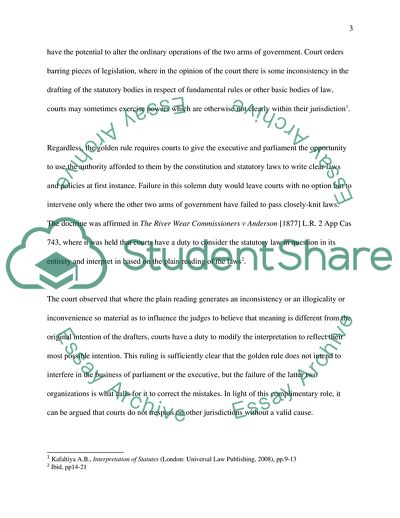Cite this document
(The Rules of Statutory Interpretation Report Example | Topics and Well Written Essays - 2000 words, n.d.)
The Rules of Statutory Interpretation Report Example | Topics and Well Written Essays - 2000 words. https://studentshare.org/law/1872427-with-reference-to-the-rules-of-statutory-interpretation-and-the-doctrine-of-binding-precedent-to-what-extent-do-uk-judges-trespass-on-the-proper-function-of-government-and-the-legislature-when-exercising-their-legal-decision-making-functions
The Rules of Statutory Interpretation Report Example | Topics and Well Written Essays - 2000 words. https://studentshare.org/law/1872427-with-reference-to-the-rules-of-statutory-interpretation-and-the-doctrine-of-binding-precedent-to-what-extent-do-uk-judges-trespass-on-the-proper-function-of-government-and-the-legislature-when-exercising-their-legal-decision-making-functions
(The Rules of Statutory Interpretation Report Example | Topics and Well Written Essays - 2000 Words)
The Rules of Statutory Interpretation Report Example | Topics and Well Written Essays - 2000 Words. https://studentshare.org/law/1872427-with-reference-to-the-rules-of-statutory-interpretation-and-the-doctrine-of-binding-precedent-to-what-extent-do-uk-judges-trespass-on-the-proper-function-of-government-and-the-legislature-when-exercising-their-legal-decision-making-functions.
The Rules of Statutory Interpretation Report Example | Topics and Well Written Essays - 2000 Words. https://studentshare.org/law/1872427-with-reference-to-the-rules-of-statutory-interpretation-and-the-doctrine-of-binding-precedent-to-what-extent-do-uk-judges-trespass-on-the-proper-function-of-government-and-the-legislature-when-exercising-their-legal-decision-making-functions.
“The Rules of Statutory Interpretation Report Example | Topics and Well Written Essays - 2000 Words”. https://studentshare.org/law/1872427-with-reference-to-the-rules-of-statutory-interpretation-and-the-doctrine-of-binding-precedent-to-what-extent-do-uk-judges-trespass-on-the-proper-function-of-government-and-the-legislature-when-exercising-their-legal-decision-making-functions.


